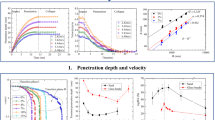Abstract
Results of a series of inverted laboratory experiments on the normal impact of spherical bodies onto targets made of wet sand (with humidity of 10%) and water-saturated sand (with humidity of 18–20%) placed into cylindrical metallic containers are reported. Experimental data are compared with results calculated by a modified Godunov difference method. Changes in the forces of resistance to penetration at different stages of the impact interaction process are analyzed, and the influence of humidity and granulometric composition of sand on the maximum values of forces at different impact velocities is studied. The maximum force of resistance for sand with 20% humidity is found to be smaller by a factor of 1.5–2 than that for dry sand.
Similar content being viewed by others
References
A. M. Bragov, V. P. Gandurin, G. M. Grushevskii, et al., “Methodical Features of Studying the Dynamic Compressibility of Soft Soils in the Pressure Interval of 0.05–1.5 GPa,” Khim. Fiz. 14 (2/3), 126–135 (1995).
A. M. Bragov and G. M. Grushevskii, “Effect of Humidity and Granulometric Composition on the Impact-Induced Compressibility of Sand,” Pis’ma Zh. Tekh. Fiz. 19 (12), 70–72 (1993).
A. M. Bragov, P. V. Demenko, L. Kruszka, et al., “Investigation of Dynamic Compressibility and Shear Resistance of Soft Soils in a Wide Range of Strain Rate and Pressure,” in Numerical Methods in Geotechnical Engineering (Presses de I’ENPC/LCPC, Paris, 2002), pp. 909–917.
V. G. Bazhenov, V. L. Kotov, S. V. Krylov, et al., “Experimental-Theoretical Analysis of Nonstationary Interaction of Deformable Impactors with Soil,” Prikl. Mekh. Tekh. Fiz. 42 (6), 190–198 (2001) [J. Appl. Mech. Tech. Phys. 42 (6), 1083–1089 (2001)].
M. Kh. Abuzyarov, V. G. Bazhenov, V. L. Kotov, et al., “Method of Discontinuity Decay in Dynamics of Elastoplastic Media,” Zh. Vychisl. Mat. Mat. Fiz. 40 (6), 940–953 (2000).
M. Kh. Abuzyarov, S. V. Krylov, and E. V. Tsvetkova, “Modeling of Hydroelastoplastic Interaction by the UPSGOD Software System,” in Problems of Strength and Plasticity (Nizhegor. Gos. Univ., Nizhny Novgorod, 2013), No. 75, pp. 25–32.
Author information
Authors and Affiliations
Corresponding author
Additional information
Original Russian Text © V.V. Balandin, Vl.Vl. Balandin, A.M. Bragov, S.V. Krylov, E.V. Tsvetkova.
Translated from Prikladnaya Mekhanika i Tekhnicheskaya Fizika, Vol. 56, No. 6, pp. 46–50, November–December, 2015.
Rights and permissions
About this article
Cite this article
Balandin, V.V., Balandin, V.V., Bragov, A.M. et al. Experimental and theoretical study of penetration of spherical solids into wet sand. J Appl Mech Tech Phy 56, 972–976 (2015). https://doi.org/10.1134/S0021894415060061
Received:
Published:
Issue Date:
DOI: https://doi.org/10.1134/S0021894415060061




